Inside The New York Botanical Garden
Esther Jackson
Posted in From the Library on July 29 2017, by Esther Jackson
Esther Jackson is the Public Services Librarian at NYBG’s LuEsther T. Mertz Library where she manages Reference and Circulation services and oversees the Plant Information Office. She spends much of her time assisting researchers, providing instruction related to library resources, and collaborating with NYBG staff on various projects related to Garden initiatives and events.
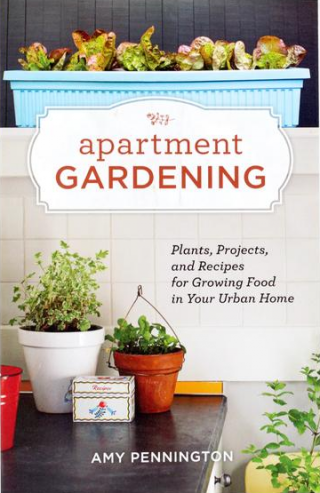 I recently discovered Amy Pennington and almost immediately fell in love with her simple, straightforward books written for city-dwellers trying to eat thriftily, sustainably, and seasonally. I reviewed both Urban Pantry and Fresh Pantry earlier this year and now have the pleasure of reviewing Apartment Gardening and Salad Days, both from Sasquatch Books, an independent press located in Seattle, WA.
I recently discovered Amy Pennington and almost immediately fell in love with her simple, straightforward books written for city-dwellers trying to eat thriftily, sustainably, and seasonally. I reviewed both Urban Pantry and Fresh Pantry earlier this year and now have the pleasure of reviewing Apartment Gardening and Salad Days, both from Sasquatch Books, an independent press located in Seattle, WA.
Apartment Gardening is geared toward readers who really want to grow garden plants at home but have no yard and little space. While Pennington has written her guide for those who have a deck or porch (sadly, not the case for many!), she’s quick to emphasize that if you have good sun *somewhere* in your urban dwelling, you can try your hand at growing vegetables, fruit, herbs, or even flowers. Not all vegetables can be successfully grown in containers, but there are a lot of vegetables that will do quite well with good sunlight, soil, and water. Roughly 80 pages of this economically sized book detail garden setup and care, with the rest of the book (181 pages total) focused on recipes, craft projects, and other simple garden tricks and tips for apartment dwellers and vegetable lovers. Apartment Gardening is a great book for new gardeners living in the urban jungle or for experienced gardeners who find themselves with limited garden space and the desire (or need!) to grow a “garden.”
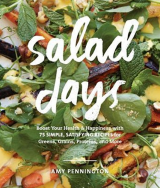 Salad Days: Boost Your Health and Happiness with 75 Simple, Satisfying Recipes for Greens, Grains, Proteins, and More is another nice book released earlier this year. Pennington shares simple but delicious recipes for the home cook. “Can a salad make you happy?” These salads created by Pennington are designed to do just that. Although you can’t grow all of the ingredients in your apartment garden, the ingredients are mostly straight-forward. Sure, salmon and avocado have their day, but a beet salad recipe contains only 10 ingredients, and that includes a dressing recipe.
Salad Days: Boost Your Health and Happiness with 75 Simple, Satisfying Recipes for Greens, Grains, Proteins, and More is another nice book released earlier this year. Pennington shares simple but delicious recipes for the home cook. “Can a salad make you happy?” These salads created by Pennington are designed to do just that. Although you can’t grow all of the ingredients in your apartment garden, the ingredients are mostly straight-forward. Sure, salmon and avocado have their day, but a beet salad recipe contains only 10 ingredients, and that includes a dressing recipe.
Overall, I just plain like Pennington’s love of growing and eating vegetables, her commitment to flavor diversity, and her sense of economy. I look forward to re-reading these four books and seeing what she thinks up next.
Posted in From the Library on July 27 2017, by Esther Jackson
Esther Jackson is the Public Services Librarian at NYBG’s LuEsther T. Mertz Library where she manages Reference and Circulation services and oversees the Plant Information Office. She spends much of her time assisting researchers, providing instruction related to library resources, and collaborating with NYBG staff on various projects related to Garden initiatives and events.
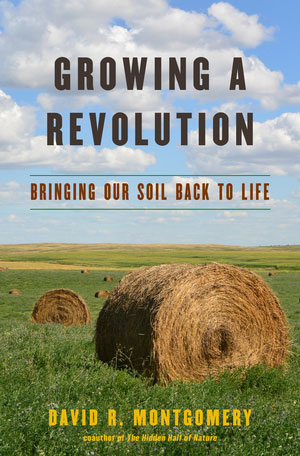 Growing a Revolution: Bringing Our Soil Back to Life by David R. Montgomery challenges the “norm” in industrial farming soil care. With research, interviews, and an engaging style of writing, Montgomery invites readers and farmers alike to consider the ways in which soil fertility can be improved with better soil care.
Growing a Revolution: Bringing Our Soil Back to Life by David R. Montgomery challenges the “norm” in industrial farming soil care. With research, interviews, and an engaging style of writing, Montgomery invites readers and farmers alike to consider the ways in which soil fertility can be improved with better soil care.
Growing a Revolution follows fast on the heels of Montgomery’s 2016 book, The hidden half of nature : the microbial roots of life and health. Montgomery, a professor of geomorphology at the University of Washington, has made a career out of soil. Revolution is the work of an author who is comfortable with his chosen subject and skilled at writing for a popular audience. The question that Montgomery poses to readers is simple, yet daunting in its scope. “What if there was a relatively simple, cost-effective way to help feed the world, reduce pollution, pull carbon from the atmosphere, protect biodiversity, and make farmers money to boot?” The answer, as readers might guess, is to cultivate good soil health.
Read More
Posted in From the Library on July 24 2017, by Esther Jackson
Esther Jackson is the Public Services Librarian at NYBG’s LuEsther T. Mertz Library where she manages Reference and Circulation services and oversees the Plant Information Office. She spends much of her time assisting researchers, providing instruction related to library resources, and collaborating with NYBG staff on various projects related to Garden initiatives and events.
 Land on Fire: The New Reality of Wildfire in the West by Gary Ferguson is a new book from Timber Press, representing the publisher’s recent dedicated exploration into more ecologically minded and popular science books.
Land on Fire: The New Reality of Wildfire in the West by Gary Ferguson is a new book from Timber Press, representing the publisher’s recent dedicated exploration into more ecologically minded and popular science books.
Land on Fire blends numerous color photographs with a narrative exploring the where, why, and when of wildfires in the western United States. Ferguson is quick to point out that fire, controlled properly, can be a valuable part of land management. Controlled (or prescribed) burns are used throughout the world, including in the New Jersey Pine Barrens, a fire-dependent ecosystem close to home.
For those who have not lived with the threat of forest fires, the images in Land on Fire are staggering and sobering. Decades of fire suppression, drought, climate change, and mass die-off of certain tree species because of invasive insects have all played their roles in wildfire season burning longer and hotter in the west. Thankfully, Ferguson ends Land on Fire with a chapter on risk reduction, presenting the three goals of the National Cohesive Wildland Fire Management Strategy—“first, to improve the ability of firefighters to respond to such emergencies; second, to restore fire-adapted landscapes (in other words, undoing some of the damage caused by 80 years of aggressive fire suppression); and finally, to create fire-adapted communities (downs and subdivisions … that will be far less prone to catastrophe from wildfire).” Meeting these three goals would, in theory, allow for better safety for people and property, save billions of dollars otherwise spent on suppression, and stabilize fire-dependent ecosystems that have been mismanaged.
Land on Fire is not totally a treatise on climate change, but it is a stark portrait of a world out of balance, thanks mostly in part to the actions of humans. Ferguson ends by writing, “clearly, we’ve still got a lot to figure out. But the incentives are high.”
Posted in From the Library on July 19 2017, by Esther Jackson
Esther Jackson is the Public Services Librarian at NYBG’s LuEsther T. Mertz Library where she manages Reference and Circulation services and oversees the Plant Information Office. She spends much of her time assisting researchers, providing instruction related to library resources, and collaborating with NYBG staff on various projects related to Garden initiatives and events.
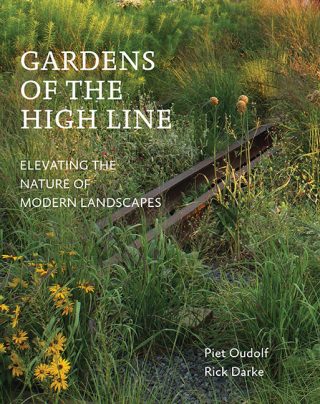 The High Line, “a public park built on a historic freight rail line elevated above the streets on Manhattan’s West Side,” is a popular NYC attraction for locals and tourists alike. Before reading Gardens of the High Line: Elevating the Nature of Modern Landscapes by Piet Oudolf and Rick Darke, I had the benefit of reading a wonderful review of the book written by Patricia Jonas for the Council on Botanical and Horticultural Libraries Newsletter. In her review, after a summary of the many books published on the High Line garden over the past six years, Jonas writes, “Could there possibly be any more vital books about the High Line yet to be published? Well, yes. Gardens of the High Line is the icing on all of this publishing and the only book to focus exclusively on the famous park’s planting design and the plants.”
The High Line, “a public park built on a historic freight rail line elevated above the streets on Manhattan’s West Side,” is a popular NYC attraction for locals and tourists alike. Before reading Gardens of the High Line: Elevating the Nature of Modern Landscapes by Piet Oudolf and Rick Darke, I had the benefit of reading a wonderful review of the book written by Patricia Jonas for the Council on Botanical and Horticultural Libraries Newsletter. In her review, after a summary of the many books published on the High Line garden over the past six years, Jonas writes, “Could there possibly be any more vital books about the High Line yet to be published? Well, yes. Gardens of the High Line is the icing on all of this publishing and the only book to focus exclusively on the famous park’s planting design and the plants.”
Gardens of the High Line is exquisite, and a treat for regular High Line visitors and those who can only admire the space from afar. In the book’s introduction, Friends of the Highline co-founder Robert Hammond writes, “when I first stepped up on the High Line in 1999, I truly fell in love. What I fell in love with was the tension. It was there in the juxtaposition between the hard and the soft, the wild grasses and billboards, the industrial relics and natural landscape, the views of both wildflowers and the Empire State Building. It was ugly and beautiful at the same time. And it’s that tension that gives the High Line its power.” This tension is captured in the photographs of Gardens of the High Line, although Lorraine Ferguson’s graphic design of the volume makes even the most “ugly” portraits of the space seem beautiful.
Less focused on the history of the space and more concerned with the gardens themselves, Gardens of the Highline is a plant lover’s dream. Each of the High Line’s 13 gardens are profiled and described with extensive photographs, including wonderful aerial photographs. These aerial shots, in particular, offer a new glimpse into this popular site’s overarching design ethos.
It’s unlikely that you’ll ever find the High Line as contemplative and empty as it appears in many of the Gardens of the High Lines photographs, but the book reminds readers why this dynamic space is so special and so worth returning to again and again throughout the seasons and years.
Posted in From the Library on July 5 2017, by Esther Jackson
Esther Jackson is the Public Services Librarian at NYBG’s LuEsther T. Mertz Library where she manages Reference and Circulation services and oversees the Plant Information Office. She spends much of her time assisting researchers, providing instruction related to library resources, and collaborating with NYBG staff on various projects related to Garden initiatives and events.
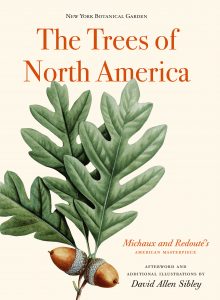 The Trees of North America: Michaux and Redouté’s American Masterpiece is a new book from The New York Botanical Garden and Abbeville Press. This beautiful volume includes 277 color plates from The North American Sylva, the first volumes of which were published in 1817 by François André Michaux (1770–1855), followed by subsequent volumes in the 1840s by Thomas Nuttall (1786–1859).
The Trees of North America: Michaux and Redouté’s American Masterpiece is a new book from The New York Botanical Garden and Abbeville Press. This beautiful volume includes 277 color plates from The North American Sylva, the first volumes of which were published in 1817 by François André Michaux (1770–1855), followed by subsequent volumes in the 1840s by Thomas Nuttall (1786–1859).
François André Michaux was a French botanist and explorer. François André with his father, Andre? Michaux (1746–1802), wrote some of the most important and widely-read books about North American flora. Susan Fraser (Vice President and Director of the LuEsther T. Mertz Library) and author Marta McDowell have written detailed introductory essays in The Trees of North America which include bibliographic information about the series and biographical information about the two Michaux explorers and Thomas Nuttall, the author who eventually completed the project.
It’s impossible to look at these plates without thinking about the early days of botany as we know it in North America. For those who love native trees, The Trees of North America is both beautiful and transportive. Certain plates, such as that of Castanea dentata, the American chestnut, are lovely and bittersweet. With accompanying illustrations by David Allen Sibley (who also wrote the afterword), The Trees of North America is an enjoyable read for all history of science and native plant enthusiasts.
Posted in From the Library on June 20 2017, by Esther Jackson
Esther Jackson is the Public Services Librarian at NYBG’s LuEsther T. Mertz Library where she manages Reference and Circulation services and oversees the Plant Information Office. She spends much of her time assisting researchers, providing instruction related to library resources, and collaborating with NYBG staff on various projects related to Garden initiatives and events.
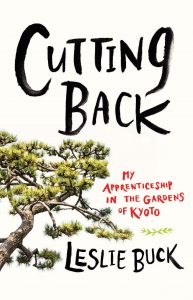 Cutting Back: My Apprenticeship in the Gardens of Kyoto by Leslie Buck is part memoir, part travelogue, and part garden design narrative. In 1999, Buck, then the owner of a pruning business in California, traveled to Japan in pursuit of an internship. Having worked with Japanese and Japanese-taught mentors previously, Buck was determined to gain additional training from Japanese craftspeople working in Japan’s famed gardens. Through the help of contacts in Kyoto, Buck obtained an internship at Uetoh Zoen, one of the oldest and most respected landscape companies in Kyoto.
Cutting Back: My Apprenticeship in the Gardens of Kyoto by Leslie Buck is part memoir, part travelogue, and part garden design narrative. In 1999, Buck, then the owner of a pruning business in California, traveled to Japan in pursuit of an internship. Having worked with Japanese and Japanese-taught mentors previously, Buck was determined to gain additional training from Japanese craftspeople working in Japan’s famed gardens. Through the help of contacts in Kyoto, Buck obtained an internship at Uetoh Zoen, one of the oldest and most respected landscape companies in Kyoto.
For the most part, it was interesting to read about Buck’s experience working on a pruning-only garden crew, as well as to learn about her attempts to understand and navigate Japanese culture as an American woman. Buck wrote that her “Bossman” was constantly challenging her with progressively more difficult tasks, and for that reason she never fully settled in to her internship or hit her stride. By the end of the book, Buck seemed to have learned about Japanese work ethic, culture, and gardening practices in spite of forgetting all the Japanese language she had learned (as she claimed).
Read More
Posted in From the Library on June 20 2017, by Esther Jackson
Esther Jackson is the Public Services Librarian at NYBG’s LuEsther T. Mertz Library where she manages Reference and Circulation services and oversees the Plant Information Office. She spends much of her time assisting researchers, providing instruction related to library resources, and collaborating with NYBG staff on various projects related to Garden initiatives and events.
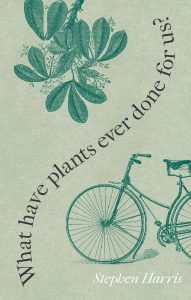 What Have Plants Ever Done for Us? is a wonderful book about botany, history, and human society. Authored by Stephen Harris, Curator of the Oxford University Herbaria and a University Research Lecturer, Plants was published in 2015. Those who read a lot of popular science books about botany will be aware that there are quite a few books published in the vein of Plants, sort of “natural history prose” about how certain plant species or plant groups have been used by humans throughout the ages.
What Have Plants Ever Done for Us? is a wonderful book about botany, history, and human society. Authored by Stephen Harris, Curator of the Oxford University Herbaria and a University Research Lecturer, Plants was published in 2015. Those who read a lot of popular science books about botany will be aware that there are quite a few books published in the vein of Plants, sort of “natural history prose” about how certain plant species or plant groups have been used by humans throughout the ages.
Poorly-researched books are a dime a dozen, which makes Plants all the more wonderful. Harris is a detail-oriented researcher who writes well, both clearly and with a very dry (sometimes hard to catch) sense of humor. Not only does Harris review and condense several more recent “a history of” publications about different plants (for example, The Pineapple: The King of Fruits or Tobacco: A Cultural History of How an Exotic Plant Seduced Civilization), he incorporates recent scholarly scientific research articles as well as notable historic works written between the 15th and 20th centuries. Harris deftly weaves his narrative with elements of history, botanical nomenclature, taxonomy, plant morphology, genetic research, and economics. In addition to very good scientific writing, there is a great deal here about the trade and colonization practices of European powers in particular, as well as elements of conservation theory.
Any lover of plants will enjoy What Have Plants Ever Done for Us?. Readers can sample a chapter or two at a time, or read the text from cover to cover. Teachers in many different disciplines—humanities and sciences both—might also find Plants to be very valuable as a teaching aid, either by assigning chapters to students as readings or using chapter topics to structure lesson plans. Having finished Plants, I am now eager to read more by Harris! In particular, Oxford Botanic Garden & Arboretum: A Brief History, Harris’s new book from University of Chicago Press.
Posted in From the Library on June 5 2017, by Esther Jackson
Esther Jackson is the Public Services Librarian at NYBG’s LuEsther T. Mertz Library where she manages Reference and Circulation services and oversees the Plant Information Office. She spends much of her time assisting researchers, providing instruction related to library resources, and collaborating with NYBG staff on various projects related to Garden initiatives and events.
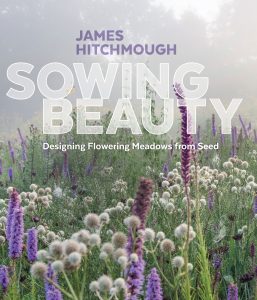 Sowing Beauty: Designing Flowering Meadows from Seed is a new book from James Hitchmough and Timber Press. Hitchmough is an established author of popular garden writing as well as a respected academic. Sowing Beauty offers readers a hybrid of academic and popular writing related to meadow garden creation featuring plants from around the world.
Sowing Beauty: Designing Flowering Meadows from Seed is a new book from James Hitchmough and Timber Press. Hitchmough is an established author of popular garden writing as well as a respected academic. Sowing Beauty offers readers a hybrid of academic and popular writing related to meadow garden creation featuring plants from around the world.
In addition to an introduction and appendices, the book itself is separated into sections titled “Looking to nature for inspiration and design wisdom,” “Designing naturalistic herbaceous plant communities,” “Seed mix design, implementation, and initial establishment,” “Establishment and management,” and “Case studies of sown prairies, meadows, and steppe.”
Sowing Beauty is an attractive and interesting book, but a hard one to classify. The book centers around Hitchmough’s unique style and somewhat radical practice of sowing meadows from seed. Sowing Beauty is home gardener-friendly in terms of content, detailing the process of meadow-sowing from start to finish. Readers learn to create seed mixes, sow their seeds, and maintain their meadows over time.
Read More
Posted in From the Library on June 1 2017, by Esther Jackson
Esther Jackson is the Public Services Librarian at NYBG’s LuEsther T. Mertz Library where she manages Reference and Circulation services and oversees the Plant Information Office. She spends much of her time assisting researchers, providing instruction related to library resources, and collaborating with NYBG staff on various projects related to Garden initiatives and events.
 Medical marijuana is a hot topic in many parts of the United States. In New York, the use of medical marijuana has been approved for the treatment of symptoms of various diseases and conditions. Those wishing to learn more about medical marijuana should consider attending NYBG’s Adult Education Medical Cannabis class which will likely be offered in the fall of this year.
Medical marijuana is a hot topic in many parts of the United States. In New York, the use of medical marijuana has been approved for the treatment of symptoms of various diseases and conditions. Those wishing to learn more about medical marijuana should consider attending NYBG’s Adult Education Medical Cannabis class which will likely be offered in the fall of this year.
While it is not legal to grow marijuana in New York, the books below offer insight into marijuana culture and history, as well as information about how marijuana is cultivated legally by those in states that permit such practices.
Smoke Signals: A Social History of Marijuana—Medical, Recreational and Scientific by Martin A. Lee chronicles the history of marijuana in America. Lee is not the first author to write a history of Cannabis sativa, but the social history focus of this book is especially interesting for readers who want to know the legal aspects of marijuana criminalization, regulation, and legislation in the United States. In addition, the author also explores contemporary medical research around using marijuana to treat conditions including cancer, heart disease, Alzheimer’s, diabetes, and chronic pain. Lee, a journalist, is skilled at drawing the reader in and also does the more motivated researcher the service of providing an extensive bibliography for further reading.
Read More
Posted in From the Library on May 15 2017, by Esther Jackson
Esther Jackson is the Public Services Librarian at NYBG’s LuEsther T. Mertz Library where she manages Reference and Circulation services and oversees the Plant Information Office. She spends much of her time assisting researchers, providing instruction related to library resources, and collaborating with NYBG staff on various projects related to Garden initiatives and events.
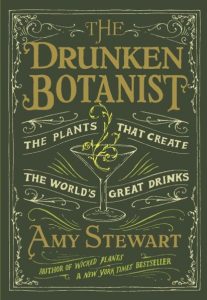 This week we dive into a few books detailing the rich history of botanical spirits, and the ways in which we’ve called on the garden to supply us with our favorite tipples.
This week we dive into a few books detailing the rich history of botanical spirits, and the ways in which we’ve called on the garden to supply us with our favorite tipples.
The Drunken Botanist: The Plants That Create the World’s Great Drinks by Amy Stewart is a treat from start to finish. Drunken Botanist follows Wicked Plants and Wicked Bugs, two excellent books about organisms that can be dangerous to humans. (Read my review of Wicked Plants here.) Stewart is a talented writer, a careful historian, an excellent amateur botanist, and a skilled bartender. Drunken Botanist follows the format of her earlier books, with Stewart selecting different plants and offering readers narratives about their nativity and the history of their usage by humans—specifically how and when they were used to make alcoholic drinks. Sake, scotch, rum, tequila, bourbon, and their plant parents are just a few of the drinks that are featured. Stewart writes, “It would be impossible to describe every plant that has ever flavored an alcoholic beverage. I am certain at this very moment, a craft distiller in Brooklyn is plucking a weed from a crack in the sidewalk and wondering if it would make a good flavoring for a new line of bitters.” Before plucking sidewalk weeds, craft distiller and home bartenders alike would do well to look to Drunken Botanist for inspiration, “stirring” stories, and an infectious excitement about plants that is one of Stewart’s enduring trademarks.
Read More
 I recently discovered Amy Pennington and almost immediately fell in love with her simple, straightforward books written for city-dwellers trying to eat thriftily, sustainably, and seasonally. I reviewed both Urban Pantry and Fresh Pantry earlier this year and now have the pleasure of reviewing Apartment Gardening and Salad Days, both from Sasquatch Books, an independent press located in Seattle, WA.
I recently discovered Amy Pennington and almost immediately fell in love with her simple, straightforward books written for city-dwellers trying to eat thriftily, sustainably, and seasonally. I reviewed both Urban Pantry and Fresh Pantry earlier this year and now have the pleasure of reviewing Apartment Gardening and Salad Days, both from Sasquatch Books, an independent press located in Seattle, WA. Salad Days: Boost Your Health and Happiness with 75 Simple, Satisfying Recipes for Greens, Grains, Proteins, and More is another nice book released earlier this year. Pennington shares simple but delicious recipes for the home cook. “Can a salad make you happy?” These salads created by Pennington are designed to do just that. Although you can’t grow all of the ingredients in your apartment garden, the ingredients are mostly straight-forward. Sure, salmon and avocado have their day, but a beet salad recipe contains only 10 ingredients, and that includes a dressing recipe.
Salad Days: Boost Your Health and Happiness with 75 Simple, Satisfying Recipes for Greens, Grains, Proteins, and More is another nice book released earlier this year. Pennington shares simple but delicious recipes for the home cook. “Can a salad make you happy?” These salads created by Pennington are designed to do just that. Although you can’t grow all of the ingredients in your apartment garden, the ingredients are mostly straight-forward. Sure, salmon and avocado have their day, but a beet salad recipe contains only 10 ingredients, and that includes a dressing recipe.
 Growing a Revolution: Bringing Our Soil Back to Life
Growing a Revolution: Bringing Our Soil Back to Life






